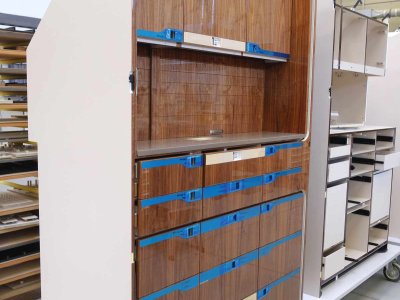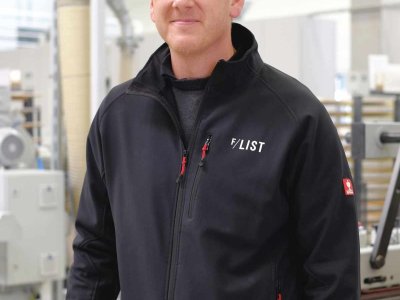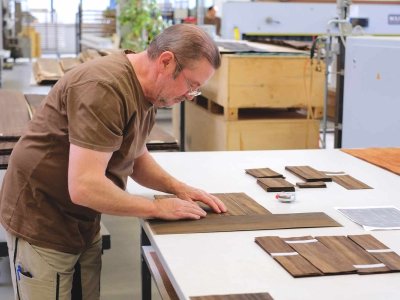F/LIST: Sanding of high-gloss edges
With remarkable production quality, Austrian aircraft interior specialist F/LIST cover over one fifth of the global market. In order to fit private- and business jets up to a Boeing 787 Dreamliner, the technological know-how required really is on another level.
The aircraft interior division is, in comparison, a rather young business segment of the renowned interior designer F/LIST. Founded in 1950 by Franz List Senior the company started out as a regular joinery company, but quickly gained a lot of respect thanks to their exclusive furniture and yacht-interiors, recalls Thomas Nix (MBA), department head of surfaces: “There are extremely high requirements regarding lightweight engineering and safety in the aircraft sector, but working on yachts is pretty demanding too.” In order to meet these requirements, F/LIST constantly focusses on their production facilities in Thomasberg, Lower Austria. Know-how is the key: “We always have to make sure that we are state of the art and re-evaluate and develop our processes. We need to achieve something others are still miles away from. Our know-how of high tech materials has evolved over the course of many years. That’s what makes the difference.” And that seems to be recognised by aircraft manufacturers such as Pilatus, Bombardier, Embraer or Boeing: “We craft about a 150 Shipsets (complete aircraft interiors) per year.” Primarily these are exclusive interiors for business jets, says Nix: “We also do refurbishments, renewing all the surfaces and retrofitting entire cabins. We construct, renew, and repair from one single element up to a complete cabin and take care of recertification.”

Joining incompatible materials
Regular furniture is no longer produced. “The only thing that’s still made from wood are the veneers and the transport boxes”, smiles Nix. Other than that, engineered materials are being used: “Ultralight honeycomb panels, foam and composite materials.” Overall about 180’000m2 of panel material is being processed at F/LIST. A new tendency leads towards carbon fibre: “It makes weight savings of up to 20% possible, and light weight is the utmost important thing next to fire resistance when it comes to aircraft construction.” Thanks to the close collaboration with Hilitech - a joint-venture between F/LIST and Hintsteiner Group - they can now develop and improve this new technology and is, once more, one step ahead of the competition: “The challenge is to evolve the right gluing and varnishing technologies”, he tells us. “We join materials like carbon and wood that would actually be incompatible in order to create a new composite material. These bonding processes, especially on curved and uneven surfaces build the core of our specialised know-how.” Developing a new process is one thing - the aircraft industry also demands very challenging test procedures and certifications: “Everything needs to be certified before it is allowed to go airborne for the first time. Sometimes it can take years until everything works as intended”, explains Thomas Nix. Therefore F/LIST’s development division works very closely with aircraft manufacturers and suppliers such as glue and paint manufacturers.”
Perfection in craftsmanship
Along with high technology - the attention to detail in craftsmanship is equally as important, emphasises Nix: “We’re serving a niche that is very demanding. The veneer work needs to be equally flawless as the technology beneath it. This is another advantage of our location here in Austria - the skill of our employees.” There are production processes that cannot be automated after all.” Examination of the veneer department shows this to be impressive. Precious veneers are being artistically composed into harmonious patterns that stretch along complex excavations and fittings. A meticulous task. The smallest mistake in one veneer could result in the renewing of a whole cabin wall, it is crucial to have an absolutely flawless veneer pattern, says Thomas Nix. It is worth mentioning that working with perfectly even surfaces is quite a rare occurrence: “Many parts are being veneered three dimensionally. And that’s an even more delicate task using the ultralight panels. We really only touch these pieces with kid-gloves, literally!
Sublime Surfaces
The surface quality is absolutely essential: “The surface department decides whether money is being made or lost”, summarises Nix. The surface department’s facilities are state of the art: “We invested a lot!” The conditions in here are downright clinical: Strict separation of tools, dust locks, high end machinery. For the most part a mirror finish comparable to that of a high end piano is being produced. But even in this, F/LIST seems to be one step ahead: “Normally, polyester is the lacquer of choice for high gloss applications. We moved away from that. We developed a new lacquer system that we expect even better results from”, says Nix. The effort behind such finishes is huge either way: The paint job is a multi step process including spraying, sanding and polishing. Most finished paint structures consist of as much as six to ten layers.”
Lacquer sanding is as important as a paint job
Often it is overlooked that a precise sanding job can have even more effect on the result than the paint-job itself: “The more accurately the sanding is performed, the better the basis for the next layer. Damage to the precious surfaces are an absolute no-go.”

Edges particularly difficult
The edges are particularly difficult when it comes to lacquer sanding: “As the surfaces are so small, the risk of damaging them increases drastically.” In some areas that are particularly delicate it is often better to sand manually and in some areas machine aided sanding is entirely impossible. “Due to the cost efficiency and more constant quality, we’re always on the lookout for machines that can do the job.” Although this is particularly difficult when it comes to lacquer edge sanding: “There aren’t many options that allow for high gloss sanding. Just one, to be precise”, Nix smiles. “The ‘Kündig’ from Switzerland. A very precise machine.”
The only one with an actuated pad
The Swiss machine that he praises so much is a Kündig Uniq-S Lacquer, an edge sander that offers an electronically controlled, pneumatic sanding pad similar to a wide belt sander. That’s why it is so suitable for sanding high gloss edges, says Nix: “We used a hand sander for these tasks before. So we could choose whether we wanted to round or break the edges. Obviously we weren’t happy with either outcome. The Kündig really perfected this. Now our edges really match the quality of the other surfaces.” To achieve such sanding quality, the specialists from Wetzikon (Zürich, Switzerland) rely on an array of technical devices: The pneumatic shoe is actuated automatically. In order to get perfect corners that are neither rounded nor damaged, its activation can be delayed or accelerated. The infinitely variable conveyor belt and sanding belt speed allow for a perfect fine tuning to the lacquer that is used. The achieved precision is improved further thanks to the well thought out conveyor belt system: “You can’t sand this accurately using your hands to guide the workpiece. The soft rubberised conveyor belts are perfect for our sensitive high gloss parts. The feed belt is equipped with white gloves, so to speak.” Considering all these aspects, Nix’s opinion concerning the machine is evident: “Kündig understand how they can combine a massive construction with top notch sanding technology. The machine allows for very careful and accurate processing of high gloss edges”, says Nix, and reiterates: “Yes, we are very satisfied with our Kündig Uniq-S Lacquer!”



